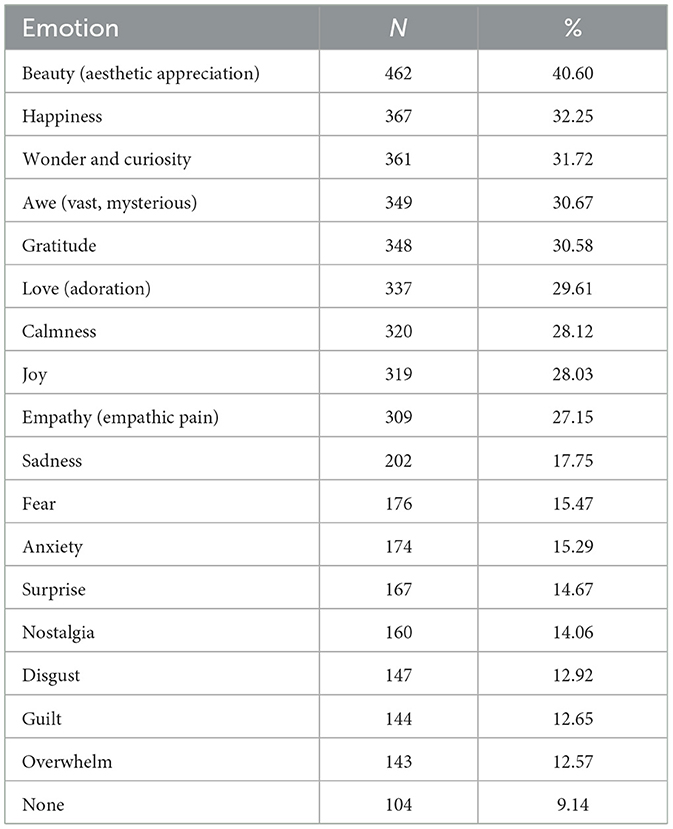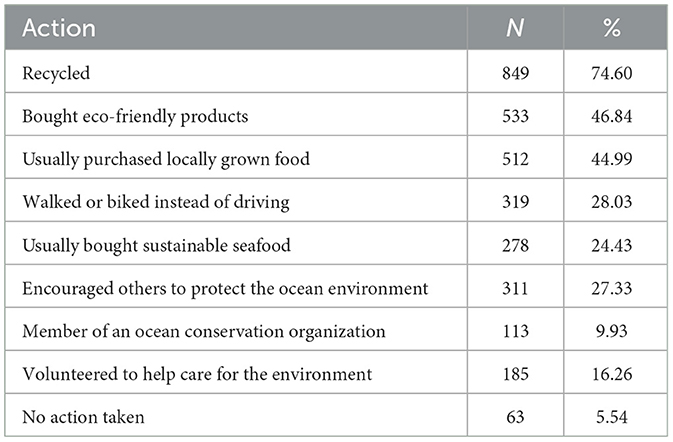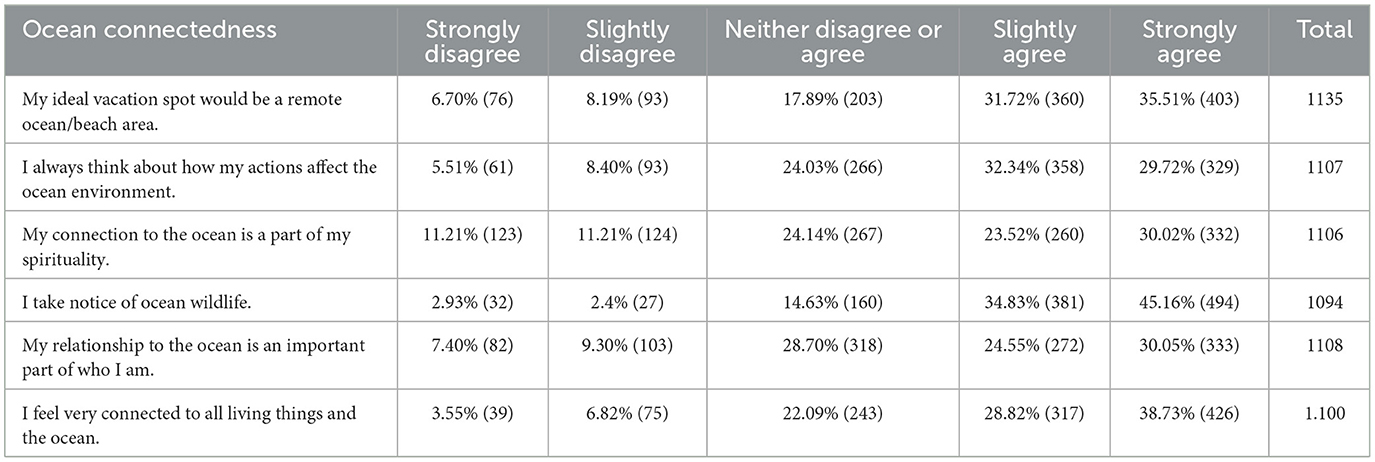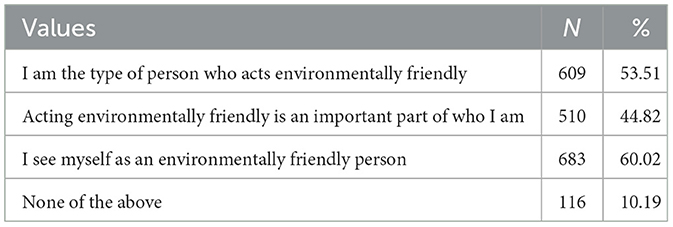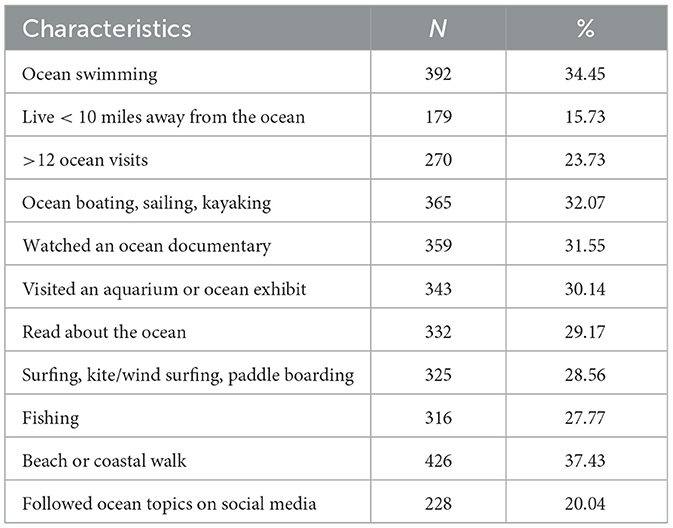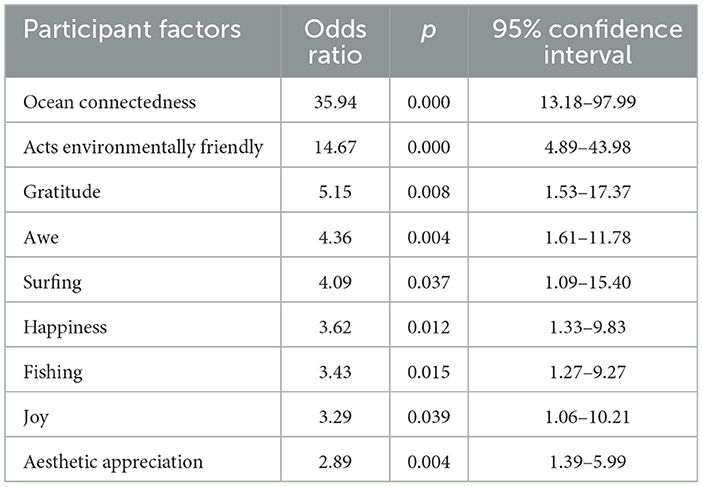- Healthy Oceans, Healthy People, Santa Cruz, CA, United States
This study investigates the association between ocean connectedness, environmental identity, emotions, and experiences with the ocean, and individuals' engagement in pro-environmental behaviors. The data from a total of 1,138 U.S. adults, standardized for age, sex, and regional location, were collected using an online survey. The results revealed ocean connectedness, environmental identity, positive emotions (happiness, gratitude, beauty, awe, joy), as well as select ocean activities (surfing and fishing) are strong predictors of individuals' engagement in pro-environmental behaviors. These findings highlight that designing ocean conservation campaigns and educational programs that leverage emotional engagement and outdoor experiences could be a key strategy to promote ocean conservation and engagement in sustainable actions. Further research is needed to confirm these relationships across different populations and environments.
1 Introduction
The vast global ocean, which covers 71% of the Earth's surface, plays a vital role in sustaining life by regulating climate, producing oxygen, providing food, and supporting a vast array of biodiversity. However, since the Industrial Revolution, human activities, especially the widespread burning of fossil fuels, have had a profound detrimental impact on marine ecosystems. Acting as a carbon sink that absorbs large quantities of carbon dioxide from the atmosphere, the ocean has absorbed over 90% of the excess heat generated by greenhouse gas emissions (IPCC, 2019). This absorption process has far-reaching consequences, including disruptions in ocean temperature regulation, ocean acidification, coral bleaching, and the loss of marine biodiversity. In addition, marine ecosystems have been severely harmed by human overfishing, plastic and chemical pollution, coastal habitat destruction and deforestation, all of which has led to rising sea levels, ocean acidification, harmful algal blooms, and dead zones (Fleming et al., 2015).
In this context, addressing ocean health, which is interconnected to human health, is more urgent than ever. Human survival and wellbeing depend on effective ocean conservation efforts (Fleming and Landrigan, 2024; United Nations, 2015). Among corresponding large-scale efforts is the recently announced the United Nations Decade of Ocean Science for Sustainable Development (2021–2030) which aims, in its Goal 14, to conserve and sustainably manage the ocean, seas, and marine resources to ensure a healthy and resilient ocean. This and other efforts are crucial for addressing biodiversity loss, pollution, and other threats to marine ecosystems (United Nations, 2020; Intergovernmental Oceanographic Commission, 2021).
Yet, along with larger-scale ocean conservation efforts such as the aforementioned United Nations Decade of Ocean Science for Sustainable Development (2021–2030), safeguarding marine ecosystems can also be supported by people's daily lifestyle choices, such as reducing plastic use, limiting seafood consumption, and lowering carbon footprints (McKinley and Fletcher, 2010). When taken collectively by many or most citizens, individual actions can significantly alleviate the pressures on our oceans. Without denying the importance of global conservation efforts on all levels (e.g., international, governmental, and community), available research demonstrates that 45%−55% of energy consumption is affected by individuals' personal behavior, such as reducing air travel, driving less, and decreasing meat consumption. These changes not only lower emissions, but also lessen the strain on fisheries, which has a direct beneficial impact on ocean health (Whitmarsh and O'Neill, 2010).
Accordingly, in recent years, many claims were made that addressing ocean health would require a more integrated approach to environmental sustainability—namely, the one that would emphasize the interconnection between environmental health and individuals' health/wellbeing (Depledge et al., 2019). Indeed, available evidence suggests that contact with safe natural environments is linked to numerous positive outcomes for human health (Lovell et al., 2018), wellbeing (Capaldi et al., 2014; McMahan and Estes, 2015), and pro-environmental behavior (Arendt and Matthes, 2016). However, to date, these benefits have typically been studied in isolation. Furthermore, recent research suggests that simply being in contact with nature may not be enough—rather, developing a psychological connection, or an emotional bond with nature, is crucial for maximizing these benefits (Capaldi et al., 2014). This brings about the need to explore how nature connectedness—and, more specifically, ocean connectedness—affects people's daily lifestyle choices and pro-environmental behaviors (PEBs).
1.1 Nature vs. ocean connectedness
According to the biophilia hypothesis, first proposed by Wilson (1986), humans have an innate connection to nature, rooted in evolutionary and genetic factors. This theory postulates that humans have developed a love for nature because of its role in providing essential resources like food, shelter, and comfort. These aesthetic preferences for natural environments trigger emotional, cognitive, and physiological responses that promote adaptive behaviors, such as finding resources and collaborating for survival (Kellert, 1993).
Furthermore, the connectedness to nature theory, another relevant theoretical framework, postulates that individuals who feel a strong bond with the natural world are more likely to engage in behaviors that protect and sustain the environment (Mayer and Frantz, 2004). This connection—whether emotional, cognitive, or experiential—fosters a sense of belonging and identification with nature. Said differently, people who see themselves as part of nature are more inclined to adopt PEBs such as reducing waste, conserving resources, and supporting conservation efforts. Linking environmental stewardship with characteristics of personal identity (see Section 1.2), this theory highlights how the latter can drive sustainable action and encourages long-term commitment to environmental protection.
Broadly defined as “the extent to which an individual includes nature within his/her cognitive representation of self” (Schultz, 2000, p. 67, the concept of connectedness to nature has been operationalized through various scales, such as the Connectedness to Nature Scale (Mayer and Frantz, 2004) or the Nature Relatedness Scale (Nisbet and Zelenski, 2013), each focusing on different aspects of emotional and cognitive connectedness (Tam, 2013).
For instance, Martin et al. (2020) found that different types of contact with nature, along with individual differences in nature connectedness, were linked to various aspects of health, wellbeing, and pro-environmental behaviors. Specifically, while living in a greener neighborhood showed no significant impact on wellbeing or sustainability outcomes, visiting nature at least once a week was positively associated with better general health and household PEBs. In addition, Martin et al. (2020) reported that people who watched or listened to nature documentaries reported higher levels of pro-environmental behavior. Nature connectedness was also positively related to eudaimonic wellbeing and both types of PEBs. Moreover, nature connectedness acted as a moderator, strengthening the relationships between nature contact, wellbeing, and PEBs (Martin et al., 2020).
Yet, a limitation of previous research on nature connectedness is that most previous studies predominantly focused on terrestrial environments, thus overlooking the unique psychological bonds people form with aquatic environments. Yet, the growing concerns over ocean health, the increasing attention to ocean literacy, and the documented benefits of ocean environments on human health and wellbeing the importance of understanding ocean connectedness (White et al., 2021). However, to date, available research on ocean connectedness has been limited to studies on specific coastal regions or protected areas (Spence et al., 2012; Tonge et al., 2015). This gap in the literature is significant, as ocean connectedness may offer a crucial link between daily consumer choices, such as sustainable purchasing, and overarching values related to marine conservation. As argued by Noujua et al. (2022), fostering deeper emotional bonds with the ocean can motivate behaviors such as reducing plastic consumption and choosing sustainable alternatives, both of which are critical to marine conservation. Overall, emotional affinity of the ocean can serve as a powerful motivator for pro-environmental behavior, particularly in contexts like product consumption (Pahl et al., 2017). Stoll-Kleemann (2019) systematic review on Behavior Change Toward More Effective Ocean Literacy suggests that integrating emotional connections into ocean literacy initiatives can lead to positive sustainable behavior change. Buchan (2021) investigation of marine citizenship found that emotional connections (enjoyment, love, passion, calm, concern, shock and sadness) to the marine environment along with marine identity and pro-environmental behaviors can motivate political and civic marine focused action for societal change (Buchan, 2021). McKinley et al. (2023) proposed an evolved model of ocean literacy with emotional connections being one of ten different dimensions that she determined influenced ocean connections and impacted sustainable behavior change. Accordingly, strengthening individuals' emotional and experiential ties to the ocean may play a key role in encouraging lifestyle changes that benefit ocean health and sustainability and enable people to better align their daily behaviors with broader environmental values that support ocean health.
1.2 Environmental identity
Along with nature/ocean connectedness, another important driver of PEBs documented in the literature is environmental identity, defined as individuals' perceptions of themselves as part of the natural environment (Clayton, 2003). Environmental identity reflects how people relate to nature, influencing their attitudes, behaviors, and commitment to pro-environmental actions. The concept of environmental identity is rooted in social identity theory (Fielding and Hornsey, 2016), whereby individuals are assumed to derive part of their self-esteem from their membership in specific social groups, including those connected to environmental advocacy. Available research suggests that a strong environmental identity is linked to greater engagement in sustainable practices and a deeper emotional connection with nature (Clayton, 2003). Environmental identity can also serve as a predictor of long-term environmental behaviors, as individuals with a robust sense of ecological self are more likely to adopt behaviors that reduce harm to the planet (Whitmarsh and O'Neill, 2010). Consequently, understanding environmental identity is critical in designing interventions and policies that promote sustained PEBs.
1.3 Emotional connections with the ocean and pro-environmental behaviors
Along with identifying the importance role of nature connectedness and environmental identity in driving PEBs, previous research also highlights the important role of emotional connections to nature in motivating conservation behaviors. For instance, several previous studies documented that the feelings of empathy, awe, joy, and even sadness can inspire individuals to take environmental action (McMahan and Estes, 2015; Lumber et al., 2017; O'Halloran and Silver, 2022). For example, awe—a profound emotion evoked by nature's vastness—enhances happiness and fosters a deeper sense of interconnection with the natural world (Keltner and Haidt, 2003). Furthermore, prior research on the effects of nature documentaries highlighted the positive emotional responses they evoke, such as awe, contentment, and curiosity, while also reducing feelings of anger and stress (Keltner et al., 2017). Collectively, these emotional responses contribute to increased awareness and action on environmental issues, demonstrating the potential of emotional engagement in fostering a conservation mindset.
Ecologists and eco-psychologists have theorized about the importance of emotional connections with the natural world in fostering pro-environmental behavior. A key aspect of this relationship is the sense of belonging to nature, which is seen as essential for motivating sustainable actions. Leopold (1949) famously argued that we disregard land because we see it as a resource that belongs to us. But when we see ourselves belonging to the land, we may start to care and respect it. This perspective highlights the need to shift from viewing nature as an external resource to recognizing our intrinsic connection to it. Similarly, Roszak et al. (1995) proposed that expanding our sense of self to include the natural environment is fundamental to ecological stewardship. Fisher (2002) further supported this idea, suggesting that cultivating this sense of belonging can lead to greater commitment to conservation and environmentally responsible behaviors.
Emotional regulation may also influence how people perceive and respond to environmental issues. Cognitive reappraisal, an emotional regulation strategy, has been shown to promote a more adaptive perception of climate change that increases sustainable actions (Panno et al., 2015, 2020). Similarly, Li et al. (2022) found that emotions influence pro-environmental choices and actions. Mindfulness, another emotional regulation strategy, has been found to positively influence pro-environmental actions in women (Ballarotto et al., 2024).
However, a limitation of previous research on pro-environmental behaviors (PEBs) is that relevant studies largely focused on land-based environments, thus largely overlooking marine ecosystems. One of the reasons underlying this discrepancy is that, while terrestrial PEBs, such as recycling, composting, and reforestation, are often tangible, visible, and directly connected to everyday life, marine environments—despite their critical role in global biodiversity and climate regulation—tend to feel psychologically distant to many people. As a result of this psychological distance, the public is frequently less aware of the environmental threats facing marine ecosystems, such as plastic pollution, overfishing, and coral reef degradation, which makes it harder to motivate marine-focused PEBs.
To address this concern, and seeking to bridge the gaps in previous research—specifically, the systematic scarcity of studies on specifically ocean connectedness and the effect of emotions on PEBs in marine environments—the present study explores how ocean connectedness, environmental identity, emotions, and ocean-related recreational experiences influence PEBs. Our goal is to identify which of these factors exert a strong impact on ocean-related environmental action and sustainable practices and to formulate actionable recommendations for environmental policymakers, educators, researchers, and ocean conservation organizations.
2 Materials and methods
2.1 Survey
The data were collected using a cross-sectional anonymous online survey targeting U.S. adults via Survey Monkey Audience (surveymonkey.com). Survey Monkey Audience, operated by Symphony Technology Group, provides access to a diverse population of respondents in exchange for donations to charity, gift card credits, or sweepstake entries. All data were self-reported by participants. The survey gathered demographic information (e.g., sex, age, race, education), as well as information on environmental identity, ocean connectedness, pro-environmental behaviors, frequency of ocean visits, time spent on ocean/beach recreation, emotions, and other related activities.
The survey was conducted on July 31 and August 1, 2024 and consisted of 12 quantitative questions and 2 qualitative questions. Quantitative data included demographic variables, environmental identity, ocean connectedness, pro-environmental behaviors, ocean activities in the past year, aspects affecting one's connection to the ocean, and emotions influencing environmental action (see Supplementary material for further detail). The two qualitative questions aimed to gather deeper insights into the study participants' ocean and beach-related experiences and perceptions (the corresponding results are not reported in this study). The participants could opt out of answering any question.
2.2 Study participants
Eligibility criteria included being at least 18 years old, residing in the United States, being able to read English, and having access to the internet to complete the survey. Informed consent was obtained electronically through Survey Monkey Audience. Of the 1,226 individuals who initiated the survey, 28 (2.3%) did not consent and were excluded from further participation. Among the remaining participants, a total of 1,138 completed the survey, while 82 individuals skipped the survey after consenting, resulting in a response rate of 93%.
The demographic characteristics of the participants are summarized in Table 1. Most of the participants were aged 45–60 years old (29.5%), followed by those aged 30–44 years (26.6%), over 60 years (24.5%), and 18–29 years (21.8%). Slightly more than half of the respondents were female (52.6%), and two thirds of the sample were White (67.8%). In terms of education level, over half (51.1%) had completed a college degree.
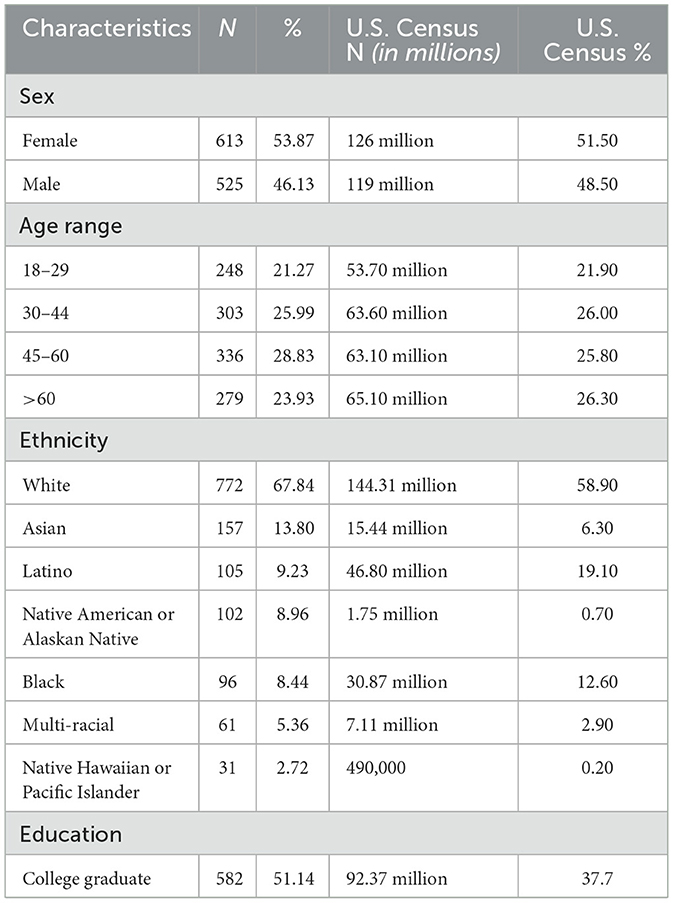
Table 1. Demographic data of participants (N = 1138) compared to U.S. census bureau data from 2020 (Worldometer, 2024).
2.3 Measurement instruments
Ocean connectedness was measured using a composite score based on the participants' responses to six items, including: “My ideal vacation spot would be a remote ocean or beach area,” “I often consider how my actions impact the ocean environment,” “My connection to the ocean is tied to my spirituality,” “I am attentive to ocean wildlife,” “My relationship with the ocean is an integral part of my identity,” and “I feel deeply connected to all living things, including the ocean.” These items were adapted from the Inclusion of Nature in Self (INS) scale, Short Form (NR-6) that reportedly “demonstrated good internal consistency, temporal stability, and predicted happiness, environmental concern, and nature contact” (Nisbet and Zelenski, 2013). The items were rated on a 5-point Likert scale. The NR-6 scale demonstrates good internal consistency (Cronbach's α = 0.82–0.87) and strong test-retest reliability (=0.85). It also exhibits high convergent validity with the full NR-21 scale (r = 0.90) and thereby supports its use as a shorter alternative.
PEBs were also evaluated through a composite score that was computed based on the study participants' ratings of the items about the following behaviors: recycling, purchasing eco-friendly products, buying seasonal or locally grown food, walking or cycling instead of driving, purchasing sustainable seafood, encouraging others to protect the ocean, membership in environmental organizations, and volunteering for environmental causes. A composite score was used because it is difficult to directly measure PEBs with a single data point. The items were adapted from 9 Pro-Environmental Behavior Items (Martin et al., 2020). The adaptation of the scale involved changing the items from Martin et al. (2020) to specifically focus on ocean conservation action. For instance, the item “Are you a member of an environmental organization?” was changed to “Are you a member of an ocean conservation environmental organization?” The Pro-Environmental Behavior scale demonstrates decent reliability (Cronbach's α = 0.76) and good construct validity and shows strong correlations with environmental identity and concern.
Environmental identity was measured using a 3-item scale comprising the items “I am the type of person who acts environmentally friendly,” “Acting environmentally friendly is an important part of who I am,” and “I see myself as an environmentally friendly person” (Van der Werff et al., 2013). Van der Werff's scale was used rather than Clayton's Environmental Identity (EID) scale as it was concise and directly targeted self identified environmental friendly behavior (Clayton, 2003). The Environmental Identity Scale demonstrates good reliability (Cronbach's α = 0.76 to 0.86). Its construct validity has strong correlations with pro-environmental behavior and attitudes.
2.4 Statistical analyses
Descriptive statistics, univariate and bivariate analyses, and logistic regression were used to quantify the strength of the associations between predictor variables and the outcome variable, PEBs (StataCorp, 2018). Descriptive statistics, including frequencies and percentages, were used to summarize participant demographics and survey responses. Univariate analyses included demographic variables. Bivariate analyses were conducted to explore associations between predictor variables (e.g., sex, age, ethnicity, frequency of ocean visits, education, proximity to the ocean, environmental identity, emotions related to ocean conservation, pro-environmental actions, and ocean activities) and PEBs.
The variables that were significantly associated with PEBs (p < 0.05) in bivariate analysis were included in the multivariable logistic regression model. This model was used to estimate the adjusted odds ratios (ORs) for pro-environmental behaviors, accounting for potential confounders such as sex, age, ethnicity, ocean visit frequency, income level, education, proximity to the ocean, environmental identity, and conservation-related emotions.
All statistical analyses were performed using Stata 18 (StataCorp LP, College Station, TX, USA). The study protocol (#24078) was approved by Salus IRB, the ethical and independent review services institutional review board.
3 Results
3.1 Emotions influencing ocean conservation
In response to the survey question “What emotions, if any, motivate you take action to help the ocean?” the participants identified a range of emotions (Table 2). The top emotions that motivated environmental action were aesthetic appreciation (40.6%), happiness (32.3%), wonder and curiosity (31.7%), awe (30.7%), gratitude (30.6%), love (29.6%), calmness (28.1%), and joy (28.0%).
3.2 Pro-environmental behaviors
To the survey question “In thinking about the past 6 months, which of the following actions have you taken?” the study participants reported a variety of PEBs (Table 3). The most common actions were recycling (74.6%), purchasing eco-friendly products (46.8%), buying locally grown food (45.0%), walking or biking instead of driving (28.0%), and purchasing sustainable seafood (24.4%). In addition, 27.3% of the participants encouraged others to protect the ocean environment, 16.3% volunteered for environmental causes, and 9.9% were members of an ocean conservation organization. Finally, 5.5% of participants reported taking no pro-environmental action.
3.3 Ocean connectedness
In response to ocean connectedness measure (Table 4), the following percentages are for the strongly agree option. “My ideal vacation spot would be a remote ocean/beach area” (35.51% strongly agreed). “I always think about how my actions affect the ocean environment” (29.72%). “My connection to the ocean is a part of my spirituality” (30.02%). “I take notice of ocean wildlife” (45.16%). “My relationship to the ocean is an important part of who I am” (30.05%). I feel very connected to all living things and the ocean (38.73%).
When asked the survey question “Which of the following impacts your connection to the ocean?” almost half of the study participants (563 or 49.5%) mentioned social connections, followed by emotional connections (37.4%), physical connections (28.5%), cultural connections (27.9%), spiritual connections (23.2%), and religious connections (19.3%).
3.4 Environmental identity
The results concerning the study participants' self-reported environmental self-identity are summarized in Table 5. More than half of the participants (60.0%) identified themselves as environmentally friendly, with 53.5% stating they actively engaged in environmentally friendly behavior. In addition, 44.8% of participants reported that being environmentally friendly was an important aspect of their personal identity. However, 10.2% of participants indicated that none of the environmental values listed applied to them. Due to concerns about multicollinearity, only one of the environmental identity variables (“I am the type of person who acts environmentally friendly”) was used in the final analysis. Using a single item instead of all three simplified the measure but did not fully capture the complexity of this identity construct, potentially underestimating its impact on environmental behavior.
3.5 Experiences with the ocean
With regard to ocean-related experiences that the respondents engaged in the past year and/or that have affected their connection to the ocean, 15.7% mentioned living within 10 miles of the ocean, and 23.7% reported visiting the ocean more than 12 times in the past year (Table 6). Other notable activities included watching an ocean documentary in the past year (31.6%), surfing or paddle boarding (28.6%), fishing (27.8%), and walking on the beach (37.4%).
3.6 Association of participant factors and pro-environmental behaviors
The variables that were found to be significantly associated with PEBs according to the results of the logistic regression analysis are summarized in Table 7. As revealed by the results, the participants with strong ocean connectedness were significantly more likely to engage in PEBs as compared to those without such connectedness (OR 35.94, 95% CI 13.18–97.99, p < 0.001).
Other variables significantly associated with PEBs included environmental identity (OR 14.67, 95% CI 4.89–43.98, p < 0.001), gratitude (OR 5.15, 95% CI 1.53–17.37, p = 0.008), awe (OR 4.36, 95% CI 1.61–11.78, p = 0.004), surfing (OR 4.09, 95% CI 1.09–15.40, p = 0.037), happiness (OR 3.62, 95% CI 1.33–9.83, p = 0.012), fishing (OR 3.43, 95% CI 1.27–9.27, p = 0.015), joy (OR 3.29, 95% CI 1.06–10.21, p = 0.039), and aesthetic appreciation (OR 2.89, 95% CI 1.39–5.99, p = 0.004). Taken together, these findings suggest that emotional responses and experiential interactions with the ocean are strongly associated with engagement in PEBs.
4 Discussion and conclusions
The results revealed that ocean connectedness, environmental identity, several positive emotions (namely, happiness, gratitude, beauty, awe, and joy), and experiential interactions with the ocean such as surfing and fishing are positively associated with PEBs. In the remainder of this section, these findings are discussed in the context of previous research.
First, the strong correlation between ocean connectedness and PEBs supports the biophilia hypothesis (Wilson, 1986), which postulates that humans have an inherent affinity for nature that shapes their attitudes and behaviors related to nature. Similarly, the present findings are also well aligned with the connectedness to nature theory (Mayer and Frantz, 2004), which postulates that individuals who feel a strong bond with the natural world are more likely to engage in behaviors that protect and sustain the environment. The results of the present study are also consistent with previous empirical research showing that a connection with nature is associated with pro-environmental behaviors (Capaldi et al., 2014), as well as that an emotional connection to the ocean can trigger more sustainable behavior, particularly in decision-making around product consumption of plastics (Pahl et al., 2020). As suggested by the present results, ocean connectedness can strengthen the belief that the health of the ocean is directly linked to human health and wellbeing, which reinforces individuals' desire to reduce ocean ecosystem harm by, among other measures, decreasing plastic waste, participating in beach clean-ups, or advocating for policies that support ocean conservation initiatives. From the applied perspective, what the present results highlight is that ocean conservation campaigns aimed at inspiring a long-term commitment to sustainability and PEBs should consider the ways to elicit and maintain the feelings of a personal connection to the ocean. Additionally, McKinley et al. (2023) proposed an enhanced model of ocean literacy that incorporates ten different dimensions (awareness, attitudes, activism, adaptive capacity, access and experience, behavior, communication, emoceans, knowledge, trust, and transparency) that impact ocean connections and ocean focused action.
Second, we found a strong correlation between environmental identity and PEBs. Specifically, the study participants who evaluated themselves as acting environmentally friendly were significantly more likely to engage in various PEBs. This finding is largely consistent with previous research showing a significant relationship between a strong environmental identity and engagement in sustainable practices (Clayton, 2003), including long-term environmental behaviors (Whitmarsh and O'Neill, 2010). In this study, Van der Werff's three-question scale was the preferred measure of environmental identity rather than Clayton's 11-question Environmental Identity (EID) scale as it directly measured self-perceived environmentally friendly behavior. The survey already assessed emotions and cognitive aspects of environmental identity. In the regression analysis only one of the three environmental identity variables was included due to multicollinearity. All three environmental identity variables were statistically significant and using a single variable improved the reliability of estimates of environmental self-identity. Future research studies could address this limitation by employing latent variable modeling or other statistical techniques to retain the multidimensionality of Van der Werff's measure.
Third, the results of our analysis highlighted a strong positive association between the emotions of gratitude, awe, joy, beauty, and happiness the participants experienced toward the ocean, on the one hand, and PEBs, on the other hand. This finding is consistent with the results of Thomas-Walters et al.'s (2023) systematic review of 128 conservation interventions that identified the key role of emotional connections in driving a positive environmental behavior change. This suggests that positive emotions experienced in natural settings, particularly in relation to the ocean, can strengthen individuals' sense of personal wellbeing and interconnectedness with the environment, which, in turn, can motivate actions that protect and preserve natural ecosystems. Therefore, from the policy perspective, our finding highlights that ocean conservation efforts may benefit from initiatives that promote emotional connections with and foster emotional responses to the ocean, including but not limited to ecotourism, public awareness campaigns, environmental education programs, marine policy initiatives, and ocean literacy programs. Such initiatives could be an effective tool for promoting ocean conservation stewardship and strengthening pro-environmental behaviors.
Finally, the last factor that was found to lead to PEBs in this study was recreational or experiential engagement with the ocean through surfing and fishing. These findings are largely consistent with previous observations that surfers with high levels of ocean exposure are more likely to engage in sustainable actions such as recycling, eating sustainable seafood, decreased plastic use (O'Halloran and Silver, 2021; Fox et al., 2021). However, Hill and Abbott (2009) investigation into the connection between Florida surfers and environmental actions found that although surfers self identified as being ecologically aware they did not actually engage in pro-environmental behaviors. Similarly, there is also evidence to suggest that surfers' spiritual connection with the ocean may also deepen their sense of respect and responsibility toward protecting it (O'Halloran and Silver, 2021). Similarly, it appears reasonable to expect that the time spent fishing may heighten people's awareness of the fragility of the oceans' limited resources and the need for sustainable practices. Overall, the time spent in or near the ocean can deepen one's environmental identity and serve as a catalyst for taking sustainable actions.
While the results of the present study provide meaningful practical implications, several limitations of our investigation need to be acknowledged. First, although we analyzed a large cohort of U.S. adults standardized for age, gender and location, the observational design may have been subject to unmeasured confounding. Second, considering that the analyses were performed on self-reported data, the risk of information bias cannot be completely ruled out. Similarly, self-reported data could have caused recall bias or social desirability bias. The third concern is selection bias, as the individuals who consented to participate in the study may have had different characteristics than those who chose not to participate. Additionally, a limitation of cross-sectional designs is that they cannot establish causal relationships as data is collected at a single point in time. Therefore, the research findings should be interpreted as associations rather than causation. Future research would benefit from longitudinal or experimental designs to assess causal effects (Lange and Dewitte, 2019). In addition, another limitation of this study is the potential influence of social desirability bias, where some individuals may overreport or underreport their environmental behaviors (Vesely and Klöckner, 2020). Finally, taking into account that the present study focused on a sample of U.S. adults, future research is needed to examine whether the identified associations will hold across different populations.
In conclusion, the present study demonstrates that emotional and experiential connections to the ocean are significant predictors of PEB engagement. Happiness, gratitude, awe, joy, and recreational activities of surfing and fishing were found to be positively influence engagement in PEBs. The observed strong associations between ocean connections and environmental identity with sustainable behaviors support the biophilia hypothesis, which suggests that a deep, personal connection to nature fosters environmental stewardship. In addition, the identified role of positive emotions—namely, gratitude awe, happiness, joy, and beauty—highlights the importance of boosting individuals' emotional engagement that can drive pro-environmental actions. Accordingly, environmental policymakers, educators, researchers, and ocean conservation organizations should consider prioritizing initiatives that foster emotional and experiential connections to the ocean, leveraging the power of personal experiences and positive emotions to inspire widespread pro-environmental behaviors and support ocean conservation stewardship. Future research should explore the role of emotional regulation in pro-environmental behavior, specifically how cognitive reappraisal and mindfulness may influence sustainable choices. Additionally, future interventions should seek to enhance personal relevance of the ocean (Schultz, 2000; Whitmarsh, 2009) and foster people's emotional connections to marine ecosystems, thereby encouraging individuals' greater engagement in conservation behaviors that protect the ocean.
Data availability statement
The original contributions presented in the study are included in the article/Supplementary material, further inquiries can be directed to the corresponding author/s.
Ethics statement
The study protocol (#24078) was approved by the Salus IRB. The studies were conducted in accordance with the local legislation and institutional requirements. The participants provided their written informed consent to participate in this study.
Author contributions
CO'H: Conceptualization, Data curation, Formal analysis, Funding acquisition, Investigation, Methodology, Writing – original draft, Writing – review & editing.
Funding
The author(s) declare that financial support was received for the research and/or publication of this article. The study was funded by the Healthy Oceans, Healthy People.
Conflict of interest
The author declares that the research was conducted in the absence of any commercial or financial relationships that could be construed as a potential conflict of interest.
Generative AI statement
The author(s) declare that no Generative AI was used in the creation of this manuscript.
Publisher's note
All claims expressed in this article are solely those of the authors and do not necessarily represent those of their affiliated organizations, or those of the publisher, the editors and the reviewers. Any product that may be evaluated in this article, or claim that may be made by its manufacturer, is not guaranteed or endorsed by the publisher.
Supplementary material
The Supplementary Material for this article can be found online at: https://www.frontiersin.org/articles/10.3389/focsu.2025.1518099/full#supplementary-material
References
Arendt, F., and Matthes, J. (2016). Nature documentaries, connectedness to nature, and pro-environmental behavior. Environ. Commun. 10, 453–472. doi: 10.1080/17524032.2014.993415
Ballarotto, G., D'Anna, V., Stefàno, L., and Velotti, P. (2024). Does mindfulness mediate the relationship between emotion regulation and pro-environmental behaviors differently based on gender? Mindfulness 15, 1958–1971. doi: 10.1007/s12671-024-02405-7
Buchan, P. M. (2021). Investigating marine citizenship and its role in creating good marine environmental health. ProQuest Dissertations & Theses, University of Exeter (United Kingdom).
Capaldi, C. A., Dopko, R. L., and Zelenski, J. M. (2014). The relationship between nature connectedness and happiness: a meta-analysis. Front. Psychol. 5:976. doi: 10.3389/fpsyg.2014.00976
Clayton, S. (2003). “Environmental identity: a conceptual and an operational definition,” in Identity and the Natural Environment: The Psychological Significance of Nature, ed. S. Clayton and S. Opotow (Cambridge, MA: MIT Press), 45–65. doi: 10.7551/mitpress/3644.003.0005
Depledge, M. H., White, M. P., Maycock, B., and Fleming, L. E. (2019). Time and tide. Br. Med. J. 366:l4671. doi: 10.1136/bmj.l4671
Fielding, K. S., and Hornsey, M. J. (2016). A social identity analysis of climate change and environmental attitudes and behaviors: insights and opportunities. Front. Psychol. 7:121. doi: 10.3389/fpsyg.2016.00121
Fisher, A. (2002). Radical Ecopsychology: Psychology in the Service of Life. Albany, NY: SUNY Press. doi: 10.1353/book4515
Fleming, L. E., Depledge, M. H., McDonough, N., White, M., Pahl, S., Austen, M., et al. (2015). “The oceans and human health,” in Oxford Research Encyclopedia of Environmental Science, ed. H. Shugart (Oxford: Oxford University Press). doi: 10.1093/acrefore/9780199389414.013.12
Fleming, L. E., and Landrigan, P. J. (2024). How can a healthy ocean improve human health and enhance wellbeing on a rapidly changing planet? Washington, DC: World Resources Institute. Available online at: https://oceanpanel.org/publications/ocean-human-health/ (accessed October 25, 2024).
Fox, N., Marshall, J., and Dankel, D. J. (2021). Ocean literacy and surfing: understanding how interactions in coastal ecosystems inform blue space user's awareness of the ocean. Int. J. Environ. Res. Public Health 18:5819. doi: 10.3390/ijerph18115819
Hill, L., and Abbott, J. A. (2009). Representation, identity, and environmental action among Florida surfers. Southeastern Geogr. 49, 157–170. doi: 10.1353/sgo.0.0044
Intergovernmental Oceanographic Commission (2021). 2021–2030 United Nations Decade of Ocean Science for Sustainable Development. Available online at: https://unesdoc.unesco.org/ark:/48223/pf0000377082 (accessed October 25, 2024).
IPCC (2019). “IPCC special report on the ocean and cryosphere in a changing climate,” in Intergovernmental Panel on Climate Change, eds. H.-O. Pörtner, D. C. Roberts, V. Masson-Delmotte, P. Zhai, M. Tignor, E. Poloczanska, et al. Available online at: https://www.ipcc.ch/srocc
Kellert, S. H. (1993). “The biological basis for human values of nature,” in The Biophilia Hypothesis, eds. S.H. Kellert and E.O. Wilson (Washington D. C: Island Press), 42–69.
Keltner, D., Bowman, R., and Richards, H. (2017). Exploring the emotional state of ‘real happiness': a study into the effects of watching natural history television content. Available online at: https://cms.bbcearth.com/sites/default/files/2022-04/bbcw-real-happiness-white-paper-final-v2-58ac1df7_2.pdf (accessed October 25, 2024).
Keltner, D., and Haidt, J. (2003). Approaching awe, a moral, spiritual, and aesthetic emotion. Cogn. Emot. 17, 297–314. doi: 10.1080/02699930302297
Lange, F., and Dewitte, S. (2019). Measuring pro-environmental behavior: review and recommendations. J. Environ. Psychol. 63, 92–100. doi: 10.1016/j.jenvp.2019.04.009
Li, H., You, C., Li, J., Li, M., Tan, M., Zhang, G., et al. (2022). Influence of environmental aesthetic value and anticipated emotion on pro-environmental behavior: an ERP study. Int. J. Environ. Res. Public Health 19:5714. doi: 10.3390/ijerph19095714
Lovell, R., Depledge, M., and Maxwell, S. (2018). Health and the natural environment: a review of evidence, policy, practice and opportunities for the future. Available online at: http://hdl.handle.net/10871/36923 (accessed October 25, 2024).
Lumber, R., Richardson, M., and Sheffield, D. (2017). Beyond knowing nature: contact, emotion, compassion, meaning, and beauty are pathways to nature connection. PLoS ONE 12:e0177186. doi: 10.1371/journal.pone.0177186
Martin, L., White, M. P., Hunt, A., Richardson, M., Pahl, S., and Burt, J. (2020). Nature contact, nature connectedness and associations with health, wellbeing and pro-environmental behaviours: results from a nationally representative survey in England. J. Environ. Psychol. 68:101389. doi: 10.1016/j.jenvp.2020.101389
Mayer, F. S., and Frantz, C. M. (2004). The connectedness to nature scale: a measure of individuals' feeling in community with nature. J. Environ. Psychol. 24, 503–515. doi: 10.1016/j.jenvp.2004.10.001
McKinley, E., Burdon, D., and Shellock, R. J. (2023). The evolution of ocean literacy: a new framework for the United Nations Ocean Decade and beyond. Mar. Pollut. Bull. 186:114467. doi: 10.1016/j.marpolbul.2022.114467
McKinley, E., and Fletcher, S. (2010). Individual responsibility for the oceans? An evaluation of marine citizenship by UK marine practitioner. Ocean Coast Manage. 53, 379–384. doi: 10.1016/j.ocecoaman.2010.04.012
McMahan, E. A., and Estes, D. (2015). The effect of contact with natural environments on positive and negative affect: a meta-analysis. J. Posit. Psychol. 10, 507–519. doi: 10.1080/17439760.2014.994224
Nisbet, E. K., and Zelenski, J. M. (2013). The NR-6: a new brief measure of nature relatedness. Front. Psychol. 4:813. doi: 10.3389/fpsyg.2013.00813
Noujua, J., Pahl, S., and Thompson, R. (2022). Ocean connectedness and consumer responses to single-use packaging. J. Environ. Psychol. 81. doi: 10.1016/j.jenvp.2022.101814
O'Halloran, C., and Silver, M. (2021). Health risks and benefits among surfers after exposure to sea water in Monterey Bay, Santa Cruz County, California, United States. Front. Mar. Sci. 8:714831. doi: 10.3389/fmars.2021.714831
O'Halloran, C., and Silver, M. (2022). Awareness of ocean literacy principle sand ocean conservation engagement among American adults. Front. Mar. Sci. 9:976006. doi: 10.3389/fmars.2022.976006
Pahl, S., Richter, I., and Wyles, K. (2020). “Human perceptions and behaviour determine aquatic plastic pollution,” in Plastics in the Aquatic Environment-Part II: Stakeholders' Role Against Pollution, eds. F. Stock, G. Reifferscheid, N. Brennholt, and E. Kostianaia (Cham: Springer International Publishing), 13–38. doi: 10.1007/698_2020_672
Pahl, S., Wyles, K. J., and Thompson, R. C. (2017). Channelling passion for the ocean towards plastic pollution. Nat. Hum. Behav. 1, 697–699. doi: 10.1038/s41562-017-0204-4
Panno, A., Carrus, G., Maricchiolo, F., and Mannetti, L. (2015). Cognitive reappraisal and pro-environmental behavior: the role of global climate change perception. Eur. J. Soc. Psychol. 45, 858–867. doi: 10.1002/ejsp.2162
Panno, A., Theodorou, A., Carrus, G., Imperatori, C., Spano, G., and Sanesi, G. (2020). Nature reappraisers, benefits for the environment: a model linking cognitive reappraisal, the “being away” dimension of restorativeness and eco-friendly behavior. Front. Psychol. 11:1986 doi: 10.3389/fpsyg.2020.01986
Roszak, T., Gomes, M. E., and Kanner, A. D. (1995). Ecopsychology: Restoring the Earth, Healing the Mind. San Francisco: Sierra Club Books.
Schultz, P. W. (2000). Empathizing with nature: the effects of perspective-taking on concern for environmental issues. J. Soc. Issues 56, 391–406. doi: 10.1111/0022-4537.00174
Spence, A., Poortinga, W., and Pidgeon, N. (2012). The psychological distance of climate change. Risk Anal. 32, 957–972. doi: 10.1111/j.1539-6924.2011.01695.x
StataCorp (2018). StataCorp Stata Statistical Software: release 11. College Station, Texas: StataCorp
Stoll-Kleemann, S. (2019). Feasible options for behavior change toward more effective ocean literacy: a systematic review. Front. Mar. Sci. 6:273. doi: 10.3389/fmars.2019.00273
Tam, K. (2013). Concepts and measures related to connection to nature: similarities and differences. J. Environ. Psychol. 34, 64–78. doi: 10.1016/j.jenvp.2013.01.004
Thomas-Walters, L., McCallum, J., Montgomery, R., Petros, C., Wan, A. K., and Veríssimo, D. (2023). Systematic review of conservation interventions to promote voluntary behavior change. Conserv. Biol. 37:e14000. doi: 10.1111/cobi.14000
Tonge, J., Ryan, M. M., Moore, S. A., and Beckley, L. E. (2015). The effect of place attachment on pro-environment behavioral intentions of visitors to coastal natural area tourist destinations. J. Travel Res. 54, 730–743. doi: 10.1177/0047287514533010
United Nations (2015). General assembly. resolution adopted by the general assembly on 25 September 2015. Available online at: https://www.unfpa.org/sites/default/files/resource-pdf/Resolution_A_RES_70_1_EN.pdf (accessed September 14, 2024).
United Nations (2020). Sustainable development goals: knowledge platform. https://sustainabledevelopment.un.org/index (accessed September 14, 2024).
Van der Werff, E., Steg, L., and Keizer, K. (2013).The value of environmental self-identity: the relationship between biospheric values, environmental self-identity and environmental preferences, intentions and behaviour. J. Environ. Psychol. 34, 55–63. doi: 10.1016/j.jenvp.2012.12.006
Vesely, S., and Klöckner, C. A. (2020). Social desirability in environmental psychology research: three meta-analyses. Front. Psychol. 11:1395. doi: 10.3389/fpsyg.2020.01395
White, M. P., Elliott, L. R., Grellier, J., Economou, T., Bell, S., Bratman, G. N., et al. (2021). Associations between green/blue spaces and mental health across 18 countries. Sci. Rep. 11:8903. doi: 10.1038/s41598-021-87675-0
Whitmarsh, L. (2009). Behavioural responses to climate change: asymmetry of intentions and impacts. J. Environ. Psychol. 29, 13–23. doi: 10.1016/j.jenvp.2008.05.003
Whitmarsh, L., and O'Neill, S. (2010). Green identity, green living? The role of pro-environmental self-identity in determining consistency across diverse pro-environmental behaviors. J. Environ. Psychol. 30, 305–314. doi: 10.1016/j.jenvp.2010.01.003
Worldometer (2024). United States population (live). Available online at: https://www.worldometers.info/world-population/us-population/ (accessed April 28, 2024).
Keywords: pro-environmental behavior, ocean connectedness, emotions, surfing activities, environmental identity
Citation: O'Halloran C (2025) Impact of ocean connectedness, environmental identity, emotions, and ocean activities on pro-environmental behaviors. Front. Ocean Sustain. 3:1518099. doi: 10.3389/focsu.2025.1518099
Received: 27 October 2024; Accepted: 01 April 2025;
Published: 25 April 2025.
Edited by:
Roberta Risoluti, Sapienza University of Rome, ItalyReviewed by:
Giulia Ballarotto, Sapienza University of Rome, ItalyPamela Buchan, University of Exeter, United Kingdom
Copyright © 2025 O'Halloran. This is an open-access article distributed under the terms of the Creative Commons Attribution License (CC BY). The use, distribution or reproduction in other forums is permitted, provided the original author(s) and the copyright owner(s) are credited and that the original publication in this journal is cited, in accordance with accepted academic practice. No use, distribution or reproduction is permitted which does not comply with these terms.
*Correspondence: Chris O'Halloran, Y2hyaXNAaGVhbHRoeW9jZWFuc2hlYWx0aHlwZW9wbGUub3Jn
 Chris O'Halloran
Chris O'Halloran